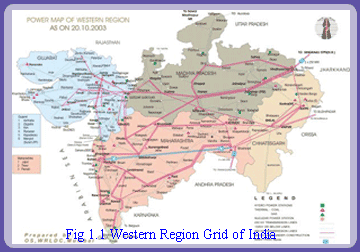| 1.1 |
Overview of Electrical Energy Systems |
| |
Electrical energy systems consists of various equipments connected together. Typically, power is generated at lower voltages (a few kV) (3-phase ac voltage source) which is stepped up by a transformer and fed into a transmission grid. Thermal power should be generated at pit heads and hydro power at reservoirs. A transmission grid is a meshed network of high voltage lines and transformers. It can have multiple voltage levels like 400 kV, 220 kV, etc. The power is delivered to load centers which may be far off (even thousands of km's apart). |
 |
 |
 |
| |
  |
Fig 1.1 shows the western region grid of India. It can be seen that large amount of generation is concentrated in the eastern end while large load centers are concentrated in the western end. The power is transferred through the ac network and HVDC lines. At load centers, voltage levels are stepped down by step down transformers in multiple stages and finally power is delivered to the end user by a distribution system which is mostly radial (no loops) in nature.
A unique feature of electrical energy systems is its natural mode of synchronous operation. It implies that during steady state the electrical frequency is same all through the system irrespective of the geographical location. This closely knits the system together. |
| |
We can perceive all generators acting in tandem like the ballet dancers in a dance. |
| |
|